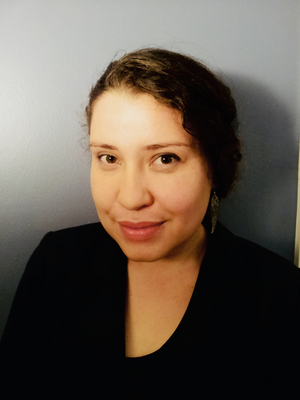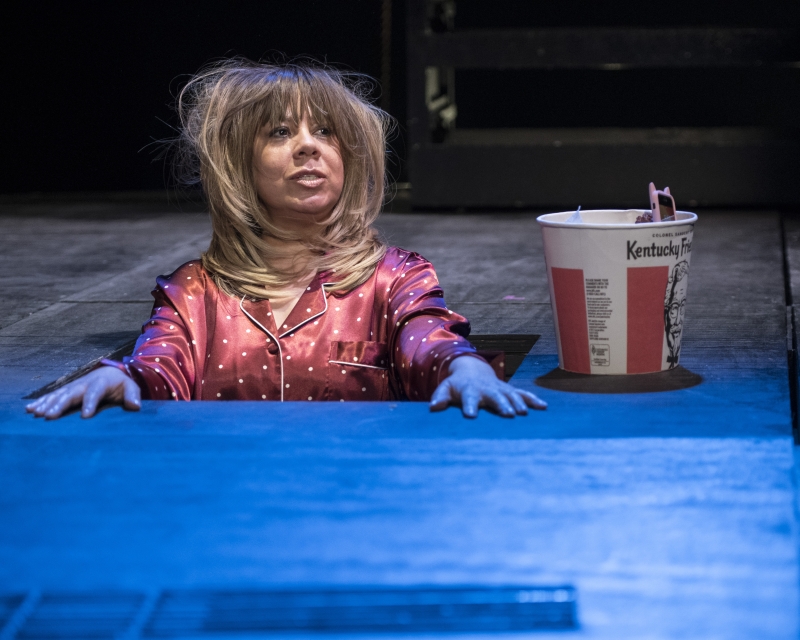Interview: Theatre Life with Ivania Stack
The highly talented costume designer on her work for Woolly Mammoth's There's Always the Hudson and more.

Today's subject Ivania Stack is currently living her theatre life as the costume designer for the World Premiere of There's Always the Hudson at Woolly Mammoth Theatre Company. The production runs through June fifth.
This goddess of the cloth is a Woolly Mammoth Theatre Company member. Over the years she has designed many productions there including Fairview, Describe the Night, Botticelli in The Fire, The Arsonists, An Octoroon, HIR, Women Laughing Alone With Salad, Zombie: The American, Lights Rise on Grace, Boom, Full Circle, A Bright New Boise, Detroit 67, The Elaborate Entrance of Chad Deity (co-design w/ Misha Kachman), and Oedipus El Rey (associate design).
Ivania has also designed for many area theatres. A few of her amazing designs include Beauty and the Beast at Olney Theatre Center, Angels in America at Round House Theatre, The Heiress at Arena Stage and many many more.
Costume design like everything else in theatre is a process. Despite what may theatregoers think, what you see onstage does not just magically appear. Read on to follow the progression for one of Ivania's designs for There's Always the Hudson.
Ivania Stack is a true artist of amazing versatility. A costume designer has to rise to the challenge of whatever each production requires. It could be a specific time period or just something the director has a vision for. Ivania has always done this and done it with her supreme design talents. Grab some tickets for There's Always the Hudson and see for yourself.
Had you been working in another part of theatre before becoming a costume designer?
I got into costume design in high school, and it just kind of stuck! I wasn't sure I was going to stick with it in college, but I ended up right back in the costume shop; I couldn't help myself! In college I did work in other areas to earn money (and learn). At George Mason University, I worked as an electrician for the Dance department productions, as well as wardrobe for the Concert Hall shows and other touring venues. I really enjoyed the teamwork and focus required to work as a technician.
Where did you receive your training?
In so many places and from so many patient, wonderful people! Starting at George Mason University, where I had great teachers and so many opportunities to design student productions. Also, with it being so close to DC, I was able to assist my mentor with professional shows, as well as attempt to design a few of my own. Those early shows did not always go well, but I learned so much from the mistakes! I also spent a few years after college freelancing, and I worked in the costume shop at the Berkshire Theatre Festival. Working there was a great opportunity to see how professional costume designers worked as well as the amazing things skilled drapers, stitchers, and craftspeople can create. After being away from college for a few years, I decided to go to graduate school at the University of Maryland. In the MFA program there, under the mentorship of Helen Huang, I got to work on my rendering and design skills. Most of all, I was able to find my own aesthetic, my design style. And though this shifts to fit each project, knowing who I am as a designer was so important. It was the difference between just getting clothes on bodies, and actually designing a show.
Who would you say was your biggest champion for becoming a costume designer?
I come from a family of scientists, actually. My dad is an organic chemist, and my mom is a physical chemist. They have both been fully supportive of my choice to go into an artistic field. And what I love about costume design is that it does require a balance, a bit of the analytical, some engineering, logistics, as well as artistic thinking. As my mom always says: "There is no science without fancy, and no art without fact." (Nabokov quote)
What was your first professional job?
It was a show at a smaller theatre company in Georgetown (company doesn't exist anymore). I was about 19 or 20, and got hired to design (and of course build) an Elizabethan show. It was awful! They only gave me $200 to buy the fabric and my sewing skills were not up to the challenge. I remember the director was furious with me, took me shopping for fabric (spent way more than $200), and I ended up asking my mom and my friends to all help me build it! It turned out fairly well, but I was definitely in way over my head!
There's Always the Hudson.
Can you please tell us a little about your costume concepts for There's Always the Hudson and also something about the play in general?
Designing the costumes for the characters in Hudson is such a fun challenge, because they tread this line between super real, and hyperbolic and heightened. This tension gives the play an electric energy. Lola and T, our main characters, have been through very real, traumatic experiences, and now they are diving into a night of chaos and revenge against their villains. Lola has dressed for the occasion, in her version of a superhero crusader outfit, and T is dressed as he always dresses, to blend in and not stand out. The contrast between their clothes is representative of their very different personalities. They complement each other, they are a dynamic duo, and their friendship is the greatest joy in the play. We thought about the other characters (a former boss, a 7-11 employee, Lola's uncle, a survivor's meeting acquaintance, and more) in the play as something like the bosses in a video game, each one to be "beat" as Lola and T progress through their revenge mission. This allows for some over the top choices in their clothes. However, as we honed the looks for each character, we (creative team) found that it was most interesting when those confrontations went against Lola and T's (and our) expectations. For example, T's former boss is rich and entitled and easy to despise, but someone else they thought was this big, bad, monster, turns out to be just sad and weird. This is what I loved about designing this play's costumes, each one requires a lot of thought, and having the input of the director (Jess McLeod), the playwright (Paola Lázaro), and Woolly's costume supervisor (Andrew Landon Cutler) really helped me with this.
Sketch courtesy of the artist.
How long from first rendering to final design does it usually take for completed designs to get on the performer?
Sometimes this could take six months to a year, other times this can be truncated to a month. For a big, period (1850s) show like The Heiress, it was definitely an 8 month span from sketch to final product. For a show like There's Always the Hudson, the time frame would usually be shorter, but in this case, due to the pandemic, it was over 2 years from sketch to realization.
Here is a sketch created a few months before the show started performances.
Sketch courtesy of the artist.
Costume designers get some pretty out there types of requests sometimes. What would you say was your most head scratching request from a director?
I love a head-scratching request! Anything that requires a bit of costume magic, or tricky engineering/ problem solving is always fun for me. One of the hardest requests to figure out are when directors ask for polar opposite things: "I want the characters to look soft, but sculptural, in neutral colors but bold, form fitting, but not tight..." Those challenges can be really fun, but there are times when you do feel like in trying to accomplish all those things, you lose hold of the design and exhaust yourself.
Otherwise, the most out there requests are from companies who want a huge period built design, but don't have a budget, won't compensate you for your time, and expect you to make everything yourself with no shop. I always want to support all theatre, whether at a big venue, or a smaller company, but sometimes I wish folks understood that what they are asking is for me to essentially donate to their theatre. Sometimes designers just can't afford to do that, even if they would like to. I think there are workarounds for this, volunteer help, borrowing from other stocks, assistance in other ways. But I would love for some producers to have a deeper understanding of how big their ask is.

Photo by Teresa Castracane Photography.
Are there any productions that stand out as favorites for you? Please explain your choices.
One of my favorite projects was School Girls; Or, The African Mean Girls Play, by Jocelyn Bioh. It was at Round House Theatre, directed by Nicole A. Watson. The play itself is so much fun, and the creative team, crew and acting company were all wonderful. The entire process was full of joy, with everyone collaborating with openness and generosity.
I also really had a great time designing Zombie: The American, at Woolly Mammoth several years ago. It was post-apocalyptic, science fiction, horror and politics! I really got to go absolutely wild, and it was as much costume designing as world-building!
And of course, The Heiress, at Arena Stage, was a career highlight. I hadn't been able to design many plays in this period, and having the support of the incredible Arena costume shop, and all their amazing skills, was a great experience. I learned so much!
With theatres announcing their 22/23 seasons, what does the new season hold in store for you?
I am really looking forward to designing Trip to Bountiful, at Ford's Theatre, and Holiday at Arena Stage in the fall. Two very different plays that require detailed, thoughtful costumes, and I am excited for the challenge!
Special thanks to Deb Fiscella of Center Stage Marketing for her assistance in coordinating this interview.
Theatre Life logo designed by Kevin Laughon.
Comments

Videos


.gif)